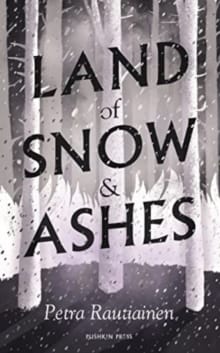
“The Land of Snow and Ashes” by Petra Rautiainen
There are not that many stories with Lapland and Finland as the location, which is why I selected to read this first novel by a Finnish author. With the two time periods, starting with the closing months of WW2, and Finnish co-operation with Nazi-Germany, and then from 1947 with a country trying to get back on it’s feet, and to re-establish a National identity alongside it’s long standing Democratic traditions, those established after their Civil War and Independence from Russia post 1917.
The story flows between the two periods with the 1944 events being the war diaries of Vaino Remes, a Finnish interpreter for the Nazis. There is another Finn, Olavi Heiskanen, who is a constant presence in the second post-war years. Alongside are one multi-lingual prisoner, Kalle, who seems to receive preferential treatment, and it is soon revealed that his true identity is actually Kaarlo Lindqvist. Vaino becomes involved, and infatuated with Saara Valva, a nurse and medic, known as the “bloodletter”; she is one of many names resurfacing in the alternating sections of the story.
In those parts covering 1947 through to 1950 the main character is photographer-cum-journalist, Inkeri Lindqvist who has bought a local house, which survived the destruction during the war time years. She plans articles on Western Lapland for National papers, but her prime purpose is to trace her husband, Kaarlo, who she has discovered was sent to this region during the war; like many others, to be seen no more. Inkeri, Olavi and local Sami man, Piera, with his teenage granddaughter Bigga-Marja, are the main cast and even a talented pig, called Matilda. We follow Inkeri as she settles into her new life, and career involving Bigga-Marja as a willing assistant. Inkeri is forever asking the locals, themselves busy constructing a new church, being built where previously camps had been located, what they know of past events many of which those involved do not want to have uncovered. These are stealthily revealed over the years as Inkeri establishes herself in the community, but trust is never that forthcoming.
There are several individuals who turn up in both sections as the events leading up to the end of the hostilities in Finland in 1944 are laid bare. Some have more secrets than others, with stories of deportations and summary massacres. This Nazi controlled part of Lapland was obviously not an ideal region to be sent to whether voluntarily or enforced. The descriptions of the countryside exposed into a wasteland, as the title depicts, are only softened by the splendours of the Northern lights. The continuous darkness of the winter months, offset only so briefly by summer’s long, long days. The Author provides a vivid view of this far off land which has suffered by the intrusion of war.
This is a very unusual story, with the background of the Finnish and Soviet relationships at that time of the last century and Finland’s past with Nazi Germany. The strands are threaded and unknotted skillfully; the local geography never makes it a “warm read” but it is a rewarding and informative narrative. `
